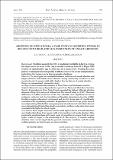Abortion Related Stigma: A Case Study of Abortion Stigma in Regions with High and Low Incidences of Unsafe Abortion
View/
Publication Date
2016-03Type
Article, Journalviews
downloads
Metadata
Show full item recordCitation
Erick Kiprotich Yegon et al. Understanding abortion-related stigma and incidence of unsafe abortion: experiences from community members in Machakos and Trans Nzoia counties Kenya. Pan African Medical Journal. 2016;24:258. [doi: 10.11604/pamj.2016.24.258.7567]
Abstract/
Background: Abortion accounts for 35% of maternal mortality in Kenya. Kenya has reported an increase in the rate of unsafe abortions from 32 to 48 per 1000 women of reproductive age in 2002 and 2012 respectively. During the same period, women presented in public health facilities with severe complications indicating that women were having unsafe abortions. Objective: To investigate the association between incidences of unsafe abortion and stigma attitudes and beliefs about abortion among community member’s in two counties located in regions with either high or low incidences of unsafe abortion. Design: A cross-sectional comparative study. Settings: General community members in Trans Nzoia and Machakos Counties. Subjects: Men and women of reproductive age in Trans Nzoia and Machakos Counties. Results: Respondents in Trans Nzoia County reported the highest full-scale abortion stigma levels (μ=55.4) compared to those from Machakos County (μ=53.07). The mean differences in SABAS scores for all the four subscales were significant for fear of contagion, exclusion and discrimination and Negative stereotyping (p-value <0.000). Incidence region, educational attainment and marital status were all significantly associated with stigmatising attitudes. Respondents in the 35-49 age group showed more stigmatising attitudes than younger respondents, and married individuals showed more stigmatising attitudes than single respondents, and lower education levels were associated with higher levels of stigma. Conclusions: Mean stigma scores for counties with high incidence of unsafe abortions were higher than those from regions with a low incidences of unsafe abortion. Male community members, those with lower levels of education were more likely to report higher levels of stigma at the community level. The majority of women seeking abortion were viewed negatively by general community members, and this could explain women’s decision to seek an unsafe abortion.
Subject/
Public health facilities; severe complications; SABAS scores; Level of education; Community members; Abortion stigma; Kenya; Qualitative methods
Further Details
Copyright for articles published in this journal is retained by the journal.
Publisher
East African Medical JournalCollections
- General - GEN [367]

